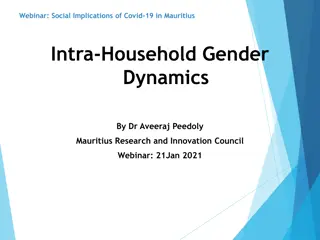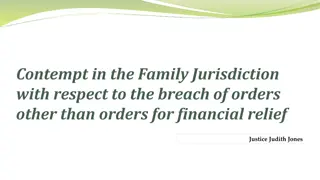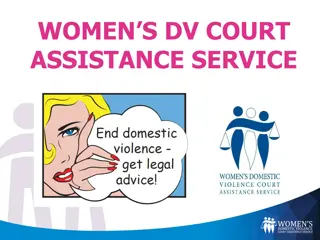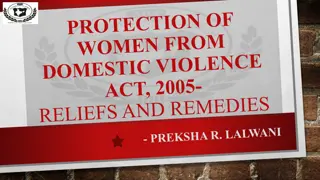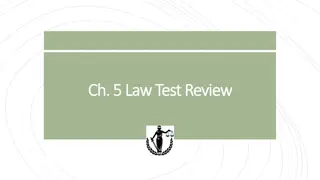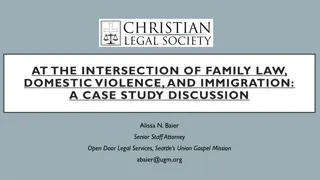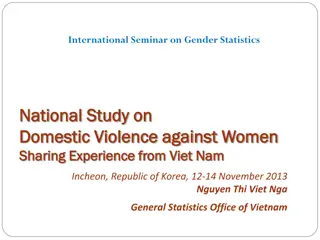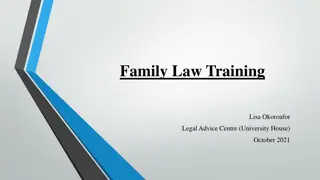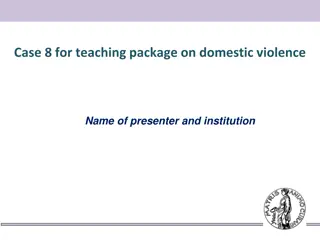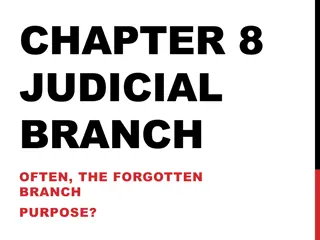Understanding Domestic Violence and Restraining Orders in California Courts
Domestic violence in California affects a significant number of individuals, with one in three women and one in four men experiencing it. This form of abuse encompasses various behaviors such as bodily injury, sexual assault, stalking, and threatening. Restraining orders play a crucial role in providing safety to victims, as they can help prevent further harm by imposing penalties for violations. It is important to raise awareness about the consequences of domestic violence and the necessity of seeking legal protection through restraining orders.
Download Presentation

Please find below an Image/Link to download the presentation.
The content on the website is provided AS IS for your information and personal use only. It may not be sold, licensed, or shared on other websites without obtaining consent from the author. Download presentation by click this link. If you encounter any issues during the download, it is possible that the publisher has removed the file from their server.
E N D
Presentation Transcript
Domestic Violence Restraining Orders in California Courts May 30, 2019 Amy Poyer Senior Staff Attorney Jennafer Dorfman Wagner Director of Programs
Domestic Violence in California
What is Domestic Violence? Abuse between spouses, co-habitants, dating partners, co- parents Current or former What is abuse? Bodily injury, sexual assault, imminent apprehension of injury to self or others Also harassing, attacking, stalking and threatening And disturbing someone s peace, which can include a broad range of behaviors including via social media Need not show that abuse resulted in actual physical injury
Who is affected by domestic violence? 1 in 3 women and 1 in 4 men nationally 4,939,000 women and 4290 men who have experienced domestic violence Females between 18-34 experience the highest rates of intimate partner violence 8.3% of teens have experienced physical dating violence Domestic violence calls are the largest category of calls received by police departments Higher rates of domestic violence among partners with financial strain Children who witness domestic violence are caught in cycle of abuse
What are the consequences of domestic violence? Half of all murders of women are connected to domestic violence One third of all female homicide victims are 18-29 years old From 2003-2008, 142 women were murdered in their workplace by former or current partners 22% of workplace homicides Higher rates of depression Complications with pregnancy and birth Monetary effects on victims and community
Restraining Orders in CA
Why get a restraining order? Makes victims feel safer 77% of women felt safer after Actually keeps victims safer Most DVROs are not violated Penalties for violation Can include up to 3 years in state prison Also fines, restitution, counseling, etc.
Civil Restraining Orders What is a civil restraining order? An order issued by a non-criminal court that can protect someone from various types of abuse, harassment, or stalking 4 main types: DVRO, elder or dependent abuse, harassment, workplace violence What is a Domestic Violence Restraining Order? Civil restraining order to protect victims from future acts of abuse Separate parties to allow them to seek a resolution of the causes of the violence
DVROs Against Abuser or threatened abuser Intimaterelationship (marriage, divorce, domestic partnership, dating and others) Relative in the 2nd degree, by marriage or blood (not discussing today) Types of Relief Enjoining specific acts of abuse Stay away and move-out orders Custody, visitation of minor child Financial protections Communications independence Who can request a DVRO, and what is the showing required? Law enforcement officer: emergency relief for up to 7 days Reasonable ground to believe there is an immediate and present danger of domestic abuse, child abuse or abduction Victim: ex parte relief (TRO) or post-hearing restraining order reasonable proof of a past act or acts of abuse
Case Example Phillips v. Campbell (2016) Woman filed for a DVRO against man who began harassing her after she rejected his interest in a romantic relationship 1) Was this a dating relationship within the DVPA? Both parties characterized relationship as friendship(no date ) There was frequent, intimate associations primarily characterized by the expectation of affection or sexual involvement 2) Was there abuse? His behavior of sending text messages to her and posting her personal information and photos online was abuse which could be enjoined under the DVPA, even though it was not physical abuse
DVROs Duration Emergency : 3-7 days (from peace officer) Temporary (Ex Parte): no more than 21 days, or with good cause, 25 days, not renewable w/out hearing Post-hearing protective orders: up to 5 years, renewable Violation Jail: up to 1 year Fine: up to $1,000 Court may issue DVRO in other proceedings Parentage, dissolution of marriage, legal separation and in juvenile court actions
Criminal Protective Orders What is a criminal protective order? Protect a witness or victim from defendant in a criminal case Purpose is to preserve integrity of criminal court proceedings Types of relief Personal conduct/stay away Witness tampering/obstruction Other protections Protection for witness and family members Defendant relinquish firearms Electronic monitoring of defendant
Criminal Protective Orders When may they be issued? Prejudgment: if harm to, or intimidation or dissuasion of, a victim or witness has occurred or is likely to occur If crime involves DV, court must consider issuing a protective order Post-judgment: if defendant is convicted of a crime involving DV Barring contact with victim or witness Probation Violation of a criminal protective order Prejudgment: contempt of court, potential other criminal charges
DVROs vs. Criminal POs DVRO Criminal Protective Order Different Purposes Purpose Stop acts of abuse, both for the victim s safety and to facilitate the resolution of violence Ensure integrity of criminal court proceedings and protect witnesses involved in such proceedings Different Types of Relief Types of relief available Stop restrained person from engaging in certain physical conduct; financial, custodial, and other relief also available More limited relief: focus on defendant s physical actions, may be directed toward, e.g., prohibiting specific acts of abuse, physical proximity, or witness intimidation. Different Procedures Involvement of victim in obtaining the order Victim may participate in the hearing and be involved in crafting the requested relief Victim is not required to be heard and might not be present when the criminal protective order is issued. Victim s ability to challenge adverse rulings Petitioner may appeal if court denies relief sought. Court must summarize its reasoning when denying a petition. Victim isn t a party to the criminal case and generally can t appeal the terms of a protective order.
DVROs vs. Criminal POs DVRO Criminal Protective Order Different Procedures (cont d) Durational limitations Post-hearing DVRO can last up to 5 years, renewable. Pre-judgment: Operative only while criminal proceedings are pending. Post-judgment: Can last up to 10 years. Modifying & terminating Court may not act on respondent s request to modify or terminate a protective order without first notifying petitioner. Protected party might not be notified until after modification or termination, crime victims guaranteed notice only upon request Ability of victim to have support person at hearing Petitioner has the option of bringing any support person of her choosing to the hearing to offer moral and emotional support. No express right to a support person Court s authority to appoint counsel to represent victim Court has express authority to appoint counsel to represent a petitioner in proceeding to enforce an existing DVPA restraining order. Victim has no right to her own counsel
Forms Most domestic violence victims are forced to represent themselves because they cannot afford an attorney To request a restraining order, complete these forms: DV-100Request for Domestic Violence Restraining Order CLETS-001Confidential CLETS Information DV-109Notice of Hearing DV-110Temporary Restraining Order If you have children with the person you want protection from, also complete: DV-105 Request for Child Custody and Visitation Orders DV-140 Child Custody and Visitation Order If you want child support or spousal/partner support, also complete one of the forms below: FL-150 Income and Expense Declaration FL-155 Financial Statement (Simplified)
Service When to serve: Your deadline for service can be calculated using Form DV-109 as completed by the court. Subtract the number of days written in item 5 on page 2 from the court date located on page 1. Service can always be completed before the deadline, but this date indicates the latest that you can serve the restrained individual. How to serve: California requires personal service for DVROs. Personal service requires: Documents must be hand-delivered, in person, to the restrained party. Youmay not deliver the papers yourself You may be allowed to serve notice by mail, publication or other means with a court order As of Jan. 1, 2019 you can ask for an order allowing alternative service. You will have to show due diligence trying personal service.
Juvenile Restraining Orders A juvenile court is a superior court exercising limited jurisdiction arising under juvenile law. Family court refers to the activities of one or more superior court judicial officers who handle litigation arising under the Family Code. Both courts have the ability to issue restraining orders to protect against domestic violence. Either court can issue a restraining order under the Domestic Violence Prevention Act, but if there is a juvenile case pending, the family court s orders cannot relate to the children. The family court can still issue a restraining order between the parents.
Renewal of a Restraining Order File your request up to 3 months before the expiration of the order Complete proper renewal form (DV-700 to request renewal, and DV-710 for notice of hearing) If your restraining order does not have an expiration date on its face, it is 3 years from the issuance Legal standard by a preponderance of the evidence that the protected party has a reasonable apprehension of future abuse reasonable apprehension of future abuse where it is more probable than not that there is a sufficient risk of future abuse Factors: Facts justifying prior order Any changed circumstances Physical violence Burden of order on restrained person Need not show further abuse to justify renewal Any violation of original DVRO is significant support for renewal
Priscila N. v. Leonardo G. (2018) Juvenile Restraining Order issued by Juvenile Court, followed by exit order in Juvenile Court issued to Family Court Petitioner attempted to renew restraining order in Family Court Family Court judge held that court did not have jurisdiction to renew, and instead considered the request as one for a new DVRO The Legislature intended that Cal. Family Code and Welfare Code are to be construed broadly to allow juvenile courts and family courts to work together Issues of different standards of legal representation in Family and Juvenile Court Higher evidentiary bar if DV victim is forced to restart in Family Court Permanent renewal is legally superior to initial order
Garcia v. Escobar (2017) Obtaining a restraining order is the same in juvenile and family court. Family Code 6345requires the order to be renewed be issued after notice and hearing, and juvenile court s restraining order is an order after hearing Family Code 6345was intended to apply to restraining orders regardless of the nature of the proceeding in which they were issued. The same underlying purpose for the lengthy renewal period (saving victims from added stress of regular renewal requirements) applies to family law trial court and juvenile court restraining orders.
Appeals If you think the judge made an error you may appeal May not appeal to present new evidence or dispute facts An appeal will not automatically stay (halt) the lower court s order, if you need a stay you must request it with the superior court Note: Criminal protective orders may not be appealed unless you are a party to the criminal action Deadline to appeal Generally, 60 days within the Notice of Entry of the order, service of an order signed by a judge and stamped filed, or 180 days after the entry of judgment Filing fee waivers are available for indigent appellants Designating the record: you must inform the superior court which documents and transcript of hearing you need for your appeal (10 days from Notice of Appeal) Filing a brief
Resources Family Violence Appellate Project https://www.fvaplaw.org Legal Resources password: FVAPtrainings6 info@fvaplaw.org (510) 858-7358 California Women s Law Center www.cwlc.org cwlc@cwlc.org (323) 951-1041





